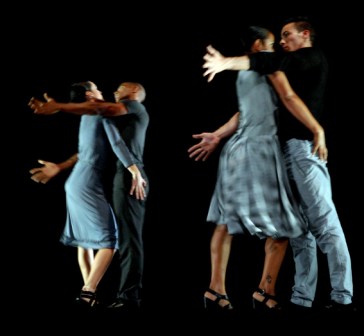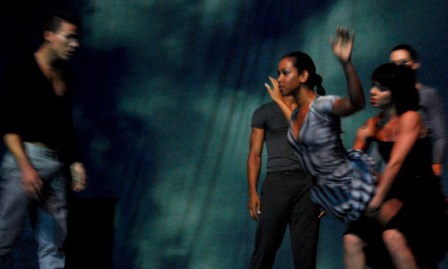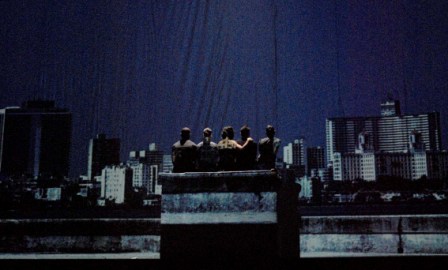Disquietude in Dance
By Irina Echarry, photos: Caridad

HAVANA TIMES, Junes 10 – How does one express the anxiety of a society without belonging to it? This question can be responded to by Susana Pous, a Spanish choreographer and dancer who works with Cuba’s Danza Abierta Company.
The troupe debuted its latest work, Malson, from June 4 to 7 at the Mella Theater in Havana, accompanied by the music and images of the multi-talented X Alfonso.
With its sober scenery and its dancers dressed in black and gray, Havana emerges in a virtual reality (projected on a screen) with blues, reds and greens each fighting for a place in the sun, a chance.
Feelings of love, isolation, selfishness and solitude -a lot of solitude- are what is recounted by the five characters that move all over the stage, in couples or not.

“Son” (the classic rhythm of the island) has become a synonym for tradition, a symbol of Cuban nationality. With a piece of this music playing in the background, the characters dance and sing while emphasizing sheer joy… until the scratched record begins to skip, repeating the same phrase, allowing one to hear (badly) the same chords.
The dancers maneuver each other around: the women guiding the men, who look like puppets, and vice versa. The scene lingers on until the tiresomeness – purposefully generated – begins to annoy the audience.
Could it be that so much son overwhelms?
Meanwhile, on the screen, a female ghost dressed in red appears before a lonely man sitting on the Havana seawall. They talk and dive into the water. People ascend, stairways are lowered, they go into the sky, traveling, and swimming among the clouds, by day or night.
They fight (uncontrolled) for a position inside an old car. The city is presented as a seething mass of people, desires, customs that occur again and again. Images repeat constantly as symbols of day-to-day existence, routine, of the impossibility of change.
In virtual reality, or that which is lived on the stage, people spurn yet seek out one other, evidencing mutual love and hate. They are together, but feel alone. The confinement doesn’t allow them to advance.

The future is only a question of time, not of paths, struggles or circumstances. The reality of the present is imposed, it doesn’t permit dreaming; it confuses.
This is why when they get together – peaceful? defeated? resigned? sad? – on the Maleconseawall Havana disappears before our eyes. The wall slowly dissolves… they are over the sea… surviving… the flight of a bird indicates that time doesn’t stop, the dancers and we the public are adrift…

This is a public that in their applause expresses total identification with the work. For that reason I have to again ask the question: How is someone able to reflect the anxiety of a society to which they don’t belong?
Susana Pous has been able to identify with our experiences, our dreams, our problems. She possesses the sensitivity to capture the emotions and express them through dance – dance that expresses the Cuban contemporariness, its uncertainty.



























